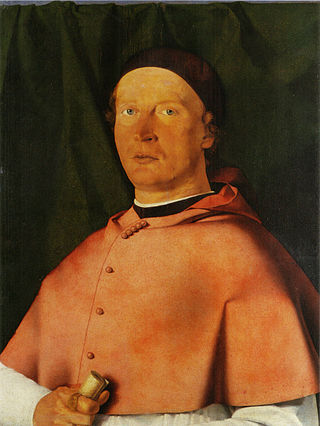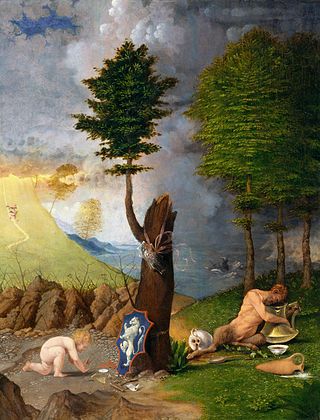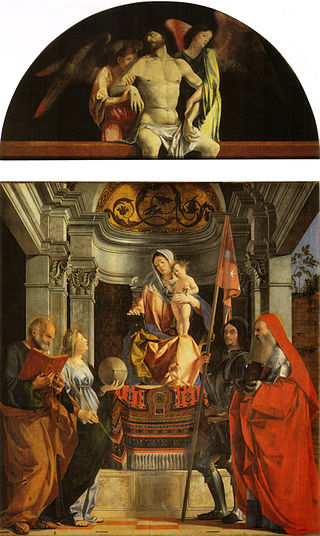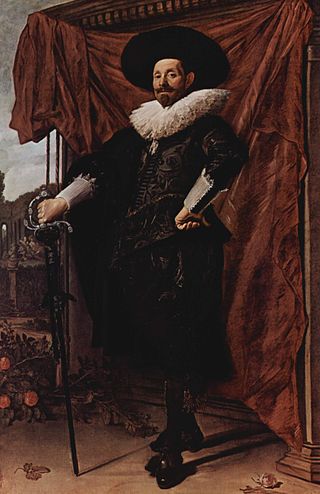Description
The picture portrays the bust a young man from three-quarter, looking at the viewer. It shows an extreme attention to details, such as the slight epidermic imperfections, the elongated nose, the soft hair. The use of light and the composition are similar to other early works by Lotto, such as the Portrait of Bishop Bernardo de' Rossi (1505). The face is framed by the dark clothes and hat, painted over a white brocade drapery with a green border.
On the right, an opening to a darker background shows a burning lamp, a symbol which could allude to the man's personality or deeds, and which has been variously interpreted (from a reference to an evangelic episode to an allegory of the human life's shortness, due to the dimness of the flame).
The subject has been identified as Broccardo Malchiostro, the young chancellor of the bishop of Treviso, Bernardo de' Rossi, who both risked their lives in a plot in 1503. The decoration of the drapery would thus be a charades: it is a brocade with carduus, whence "Brocade + carduus = Brocardus". Such allusions are contained in several Lotto works, such as the Portrait of Lucina Brembati , painted during his maturity.

Lorenzo Lotto was an Italian painter, draughtsman, and illustrator, traditionally placed in the Venetian school, though much of his career was spent in other north Italian cities. He painted mainly altarpieces, religious subjects and portraits. He was active during the High Renaissance and the first half of the Mannerist period, but his work maintained a generally similar High Renaissance style throughout his career, although his nervous and eccentric posings and distortions represented a transitional stage to the Florentine and Roman Mannerists.

Giovanni Battista Moroni was an Italian painter of the Late Renaissance period. He also is called Giambattista Moroni. Best known for his elegantly realistic portraits of the local nobility and clergy, he is considered one of the great portrait painters of sixteenth century Italy.

Bernardo Strozzi, named il Cappuccino and il Prete Genovese was an Italian Baroque painter and engraver. A canvas and fresco artist, his wide subject range included history, allegorical, genre and portrait paintings as well as still lifes. Born and initially mainly active in Genoa, he worked in Venice in the latter part of his career. His work exercised considerable influence on artistic developments in both cities. He is considered a principal founder of the Venetian Baroque style. His powerful art stands out by its rich and glowing colour and broad, energetic brushstrokes.

Paris Bordone was an Italian painter of the Venetian Renaissance who, despite training with Titian, maintained a strand of Mannerist complexity and provincial vigor.

Francesco Salviati or Francesco de' Rossi was an Italian Mannerist painter who lived and worked in Florence, with periods in Bologna and Venice, ending with a long period in Rome, where he died. He is known by various names, usually the adopted one of Francesco Salviati or Il Salviati, after an early patron, but also Francesco Rossi and Cecchino del Salviati.
Events from the year 1505 in art.

The Portrait of Lucina Brembati is an oil-on-panel painting by the Italian High Renaissance painter Lorenzo Lotto, dating to c. 1518. It is housed in the Accademia Carrara of Bergamo, northern Italy.

Bernardo de' Rossi was an Italian bishop and patron of the arts.

The Portrait of Bishop Bernardo de' Rossi is an oil-on-panel painting by the Italian High Renaissance painter Lorenzo Lotto, dating to 1505. It is housed in the National Museum of Capodimonte of Naples, southern Italy.

The Allegory of Virtue and Vice is an oil-on-panel painting by the Italian High Renaissance painter Lorenzo Lotto, dating to 1505. It is housed in the National Gallery of Art in Washington, DC, United States.

Malchiostro Annunciation is a painting by the Italian Renaissance artist Titian, completed around 1520, and housed in the Cathedral of Treviso, northern Italy.

The Pinacoteca del Castello Sforzesco is an art gallery in the museum complex of the Castello Sforzesco in Milan, northern Italy.

Santa Cristina al Tiverone Altarpiece is an oil-on-panel painting by the Italian Renaissance painter Lorenzo Lotto, executed around 1504–1506. It is still housed in its original location, the parish church of Santa Cristina in Quinto di Treviso, a frazione of Treviso, northern Italy.

Willem van Heythuysen posing with a sword is an oil-on-canvas painting by the Dutch Golden Age painter Frans Hals, painted in 1625-1630, and now in the Alte Pinakothek, in Munich. It shows the Haarlem cloth merchant Willem van Heythuysen in a theatrical pose with a rapier.

The Triple Portrait of a Goldsmith is an oil-on-canvas painting by the Italian Renaissance artist Lorenzo Lotto, created c. 1530 and now held in the Kunsthistorisches Museum in Vienna. It has previously been attributed to other artists such as Titian until documentary evidence was found linking it to a painting of the same description in various collection inventories. In 1627 it was in the collection of Vincenzo II Gonzaga, who sold it to Charles I of Great Britain, upon whose execution it was auctioned to Philip IV of Spain. It eventually entered the Habsburg collections in Austria via inheritance – inventories show it has been in Vienna since at least 1733.

Madonna and Child with St Peter Martyr and a Donor is a 1503 oil-on-panel painting by Lorenzo Lotto, the first known work by the artist, painted early in his time in Treviso. The two figures to the left are Peter Martyr and a donor or the infant John the Baptist. Its date is inscribed on the reverse as "1503 adì 20 septembris" and – although it is not in Lotto's handwriting as seen in documents – it is a 16th-century hand and therefore accepted.

Allegory of Chastity is a c.1505 oil-on-panel painting by the Italian Renaissance artist Lorenzo Lotto.

Portrait of an Old Man with Gloves is an oil-on-canvas painting by the Italian High Renaissance artist Lorenzo Lotto. It is assigned a date c.1543 on the basis of stylistic similarities with Portrait of Febo da Brescia, Portrait of a Thirty-Seven-Year-Old Gentleman and other works produced by the artist in the mid 1540s. Its final private owner was count Castellane Harrach of Turin, from whose collection it entered the Pinacoteca di Brera in Milan in 1859, where it still hangs.

Portrait of Marsilio Cassotti and His Bride Faustina is a 1523 oil-on-panel painting by Lorenzo Lotto, now in the Prado Museum in Madrid. It is signed and dated "L. Lotus Pictor / 1523". It is the first known marriage portrait produced in Italy, inspired by prints from Germany and the Low Countries.

Saint Jerome in Penitence is an oil-on-panel painting by Italian Renaissance artist Lorenzo Lotto. Its signature ("Lotus") is fully legible, but the final number of the date is illegible, though it is usually dated to around 1506. It is now in the Louvre.


















